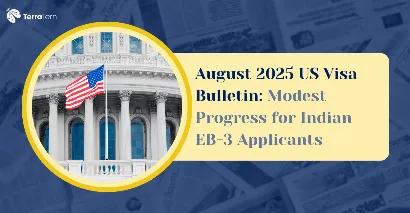Key Highlights
- Understanding the US Visa Bulletin: A Critical Update for Immigrants
- Key Developments in the August 2025 Visa Bulletin
- Warning: Approaching Annual Limits and Retrogression
- Family Sponsored Visa Categories: Little change
- Family-Sponsored Green Cards: Final Action Dates (August 2025)
- Why is Progress Slow for Indian Nationals?
- EB Green Card Final Action Dates for India (August 2025)
- State Department’s Warning: Demand, Retrogression, and Temporary Closure
- Navigating the Road Ahead: What Applicants Should Do?
- Conclusion
Eight years in the making, the much-anticipated August 2025 US Visa Bulletin brings the voyagers a deja vu of conjecture and insecurity to the green card applicants as well, particularly the Indian citizens waiting in excessive employment-based lines. The recent entry in the bulletin offers a slight improvement in the EB-3 line for Indians, but also repeats the threats of the upcoming retrogression caused by the close annual visa quotas. Applicants, lawyers, and families are now trying to get ready for the next few weeks and to interpret the voluminous modifications affecting thousands of immigration stories.
Understanding the US Visa Bulletin: A Critical Update for Immigrants
The US Department of State releases its Visa Bulletin on a monthly basis, to which all green card hopefuls should refer in order to get updates on their application status. It outlines two important sets of dates for each type of visa and for each country:
-
Final Action Dates: Describe the time when the green card can be given.
-
Dates of Filing: Provide the earliest dates that applicants may file to adjust status or to file an immigrant visa.
USCIS releases a statement each month to determine the chart that is to be used by the applicants (Final Action or Dates for Filing). To consider eligibility under the employment-based category, the Final Action Dates chart should be used in the case of August 2025.
Also Read: Spouse Visa Canada: Latest Eligibility, Time & Benefit
Key Developments in the August 2025 Visa Bulletin
Nuance changes are provided on the bulletin of August 2025, notably for the Indian applicants in the employment-based category, although the majority of the family-based classification remained unchanged.
EB-3 India: Advancement of One Month
The Indian nationals are doing well in the EB-3 (Skilled Workers and Professionals) movement. The final action date moves forward by one month, i.e., from April 22, 2013, to May 22, 2013. This is, though, a small step, but comes as a relief to many Indian EB-3 applicants who have been waiting more than ten years to be given a green card.
No movement in EB-2 and EB-1 India
The EB-1 (Priority Workers) of India is the same as that of February 15, 2022, and EB 2 (Advanced Degree Professional or Exceptional Ability) is still at January 1, 2013. Such stagnant dates imply that the long queues still apply to the enormous Indian pool of these professions.
The Indian EB-5: a giant step forward
EB-5 Unreserved India leaps almost more than 6 months with a new date of Final Action of November 15, 2019. The set-aside subcategories of EB-5, namely, rural, high-unemployment, and infrastructure, are and always will be considered to be in the current state, and this makes all applicants immediately eligible in these categories.
Also Read: What Exams Are Required to Study Abroad?
Warning: Approaching Annual Limits and Retrogression
State Department has issued clear warnings that there may be retrogression or categories that will be rendered unavailable. EB-2 and EB-3 in India are quickly reaching their numerical limitations. In the event of reaching, processing could stop until October 1, 2025, when a new fiscal year starts. The candidates are warned to be careful since there might be retrogression, which would shut out new approvals until the next year.
Family Sponsored Visa Categories: Little change
Most Indian family view categories are being kept as they were (with a three-month revocation of the date under the F4 (blood relatives of grown-up US citizens) to November 1, 2006). No movement is experienced in the other preference categories that include F1, F2A, F2B, and F3.
Family-Sponsored Green Cards: Final Action Dates (August 2025)
|
Category |
India (Final Action Date) |
|
F1 (Unmarried Sons/Daughters US Citizens) |
July 15, 2016 |
|
F2A (Spouses/Children Perm. Residents) |
Sept 1, 2022 |
|
F2B (Unmarried 21+ Perm. Residents) |
Oct 15, 2016 |
|
F3 (Married Sons/Daughters US Citizens) |
Aug 1, 2011 |
|
F4 (Siblings US Citizens) |
Nov 1, 2006 |
Why is Progress Slow for Indian Nationals?
Per-country limits (7% for each country per category) combined with high demand mean Indian applicants, particularly in EB-2 and EB-3, face extremely long backlogs. With no significant legislative reform and family members counted in visa usage, slowdowns are inevitable.
EB Green Card Final Action Dates for India (August 2025)
|
Category |
Final Action Date |
Status |
|
EB-1 |
Feb 15, 2022 |
Unchanged |
|
EB-2 |
Jan 1, 2013 |
Unchanged |
|
EB-3 |
May 22, 2013 |
Advanced by 1 month |
|
EB-5 Unreserved |
Nov 15, 2019 |
Advanced 6.5 months |
Note: The “current” label for EB-5 Set-Aside means Indians qualifying for Rural, High Unemployment, or Infrastructure investments face no waiting period.
Also Read: IELTS Age Limit – Everything You Need to Know
State Department’s Warning: Demand, Retrogression, and Temporary Closure
What does Retrogression Mean?
Retrogression happens when the number of visas that are demanded in a particular category turns out to be more than the number of visas available in a financial year, so that the cutoff dates run backward (or in extreme cases, the category is closed). With EB-2 and EB-3 India very close to their limits, spontaneously stopping approvals until October 2025 is to be expected with continued high demand.
What Does It Mean to Applicants?
-
Applicants who find their priority dates regressing will take even more time to be called to take their green cards after application, despite the fact that the applicant may already have filed his or her application.
-
The risk of unemployment and disruption of family increases when there are categories that become unavailable before the end of a fiscal year.
-
Qualified and existing customers of this month would hurry to make the subsequent processes.
The Difference Between the Filing date and Final Action Date: Why it Matters?
-
Final Action Date: This dates the green card approvals; when an application on your side can be processed and you will be given permanent residency.
-
Filing Dates: Indicates the times when you can file your adjustment of status or immigrant visa process which entraps some of your benefits, including work authorization, before the green card is granted.
To all applicants who obtain a green card due to employment in August 2025, we would advise the applicants to go through the Final Action Date chart in order to determine their eligibility.
Navigating the Road Ahead: What Applicants Should Do?
-
Keep track of the Visa Bulletin: It is essential that the green card applicants monitor the bulletin on a monthly basis in order to know what has been changing.
-
File immediately: In the case of the current, any of those persons, the priority date of whom has now become current, should, as soon as possible, file all the required documents.
-
Uncertainty Plan: Retrogression and the unavailability of categories may alter the waiting period considerably- it is prudent to have a backup plan.
-
Note E-B5 Set-Aside Opportunities: A prospective investor, in case he is eligible, can avoid the long line of people by applying in rural, high-unemployment or infrastructure set-aside section.
-
Get Professional Advice: Immigration can be a rapidly developing environment, and a professional has to be consulted.
Also Read: US Tourist Visa Cost for Indian: Latest Guide & Fees
Conclusion
Many of the Indian EB-3 hopefuls to whom the August Visa Bulletin 2025 gives the small amount of welcome elation that they have been out of the waiting line are reminded that the bigger picture is the incapacitated state that the employment-based green card queues are in by the fact that queue position has not advanced in years, and the numbers of the categories are now restricted. The impending threat of retrogression points to the danger of an impasse in foreign green card approvals in the most oversubscribed categories and is all the more reason to be cautious and act in time as well as seek professional counselling. With the close of the current fiscal year looming ahead, there is the hope that with enough advocacy and policy focus, someday soon, there can be actual relief to those many who continue to wait in line.
To learn more about the latest immigration needs, contact TerraTern right away!








